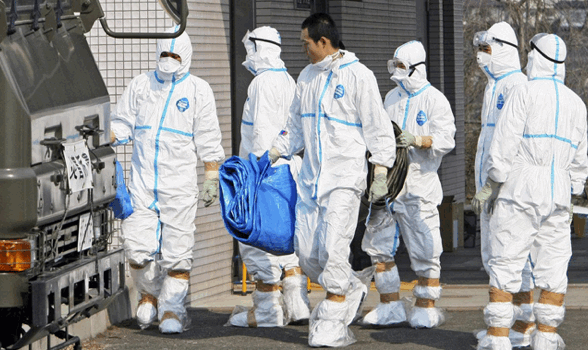Via The Guardian & Natural News

The battle to save the Fukushima nuclear power plant now appears lost as the radioactive core from Reactor No. 2 has melted through the containment vessel and dropped into the concrete basement of the reactor structure. This is “raising fears of a major release of radiation at the site,” reports The Guardian, which broke the story. Richard Lahey, who was head of safety research for boiling-water reactors at General Electric when the company installed the units at Fukushima, told the Guardian workers at the site appeared to have “lost the race” to save the reactor, but said there was no danger of a Chernobyl-style catastrophe.
Workers have been pumping water into three reactors at the stricken plant in a desperate bid to keep the fuel rods from melting down, but the fuel is at least partially exposed in all the reactors.
At least part of the molten core, which includes melted fuel rods and zirconium alloy cladding, seemed to have sunk through the steel “lower head” of the pressure vessel around reactor two, Lahey said.
“The indications we have, from the reactor to radiation readings and the materials they are seeing, suggest that the core has melted through the bottom of the pressure vessel in unit two, and at least some of it is down on the floor of the drywell,” Lahey said. “I hope I am wrong, but that is certainly what the evidence is pointing towards.”
The major concern when molten fuel breaches a containment vessel is that it reacts with the concrete floor of the drywell underneath, releasing radioactive gases into the surrounding area. At Fukushima, the drywell has been flooded with seawater, which will cool any molten fuel that escapes from the reactor and reduce the amount of radioactive gas released.
Lahey said: “It won’t come out as one big glob; it’ll come out like lava, and that is good because it’s easier to cool.”
The only feasible interpretation from this analysis is that radiation emissions from Fukushima could suddenly become much greater. It is also now obvious that the radioactive fallout from Fukushima will last for decades, if not centuries.
Japan’s Prime Minister Naoto Kan last night admitted the situation at Fukushima remains “unpredictable.” Meanwhile, the presence of plutonium in soil samples is proof that the nuclear fuel rods have been compromised and are releasing material into the open atmosphere.
Robert Peter Gale, a US medical researcher who was brought in by Soviet authorities after the Chernobyl disaster, in 1986, has met Japanese cabinet ministers to discuss establishing an independent committee charged with taking radiation data from the site and translating it into clear public health advice.
“What is fundamentally disturbing the public is reports of drinking water one day being above some limit, and then a day or two later it’s suddenly safe to drink. People don’t know if the first instance was alarmist or whether the second one was untrue,” said Gale.
What’s next: Radioactive gas
So what happens now that the fuel core from Reactor No. 2 has burned its way through the containment vessel and dropped to the concrete floor? It follows the laws of physics, of course: The super-heated nuclear fuel reacts with the concrete material in the floor, producing highly radioactive gas which now runs the risk of escaping into the atmosphere if it gets through the outer containment wall.
The drywell is surrounded by a secondary steel-and-concrete structure designed to keep radioactive material from escaping into the environment. But an earlier hydrogen explosion at the reactor may have damaged this.
“The reason we are concerned is that they are detecting water outside the containment area that is highly radioactive and it can only have come from the reactor core,” Lahey added. “It’s not going to be anything like Chernobyl, where it went up with a big fire and steam explosion, but it’s not going to be good news for the environment.”
It’s now clear however that the Fukushima nuclear complex is going to emit radiation for a very, very long time. It now seems almost certain that Japan must bury the facility under millions of tons of concrete and sand.
How do you bury Fukushima for good?
The problem is that there’s not even enough concrete in Japan to handle the job. To accomplish such a task, Japan would have to import not only thousands of pieces of industrial concrete-handling trucks and machinery; it would also have to import concrete materials by the ship-load. We’re talking about millions of tons of concrete materials, shipped in by ocean, from all over the world.
Has anybody done the math on how long that will take to coordinate? Just getting the materials shipped to Japan within 30 days would be a miracle. And you can’t just plop down concrete and hope it sticks: You have to engineer the concrete effort so that it can resist future tsunamis and earthquakes. Normally, this would be at least a five-year project.
Essentially, you have to build a whole new massive concrete containment structure on top of the existing nuclear complex. And remember: It was the corruption and cover-ups from the first such engineering project that helped cause this situation in the first place!




I think this world we’re in is beyond the point no return